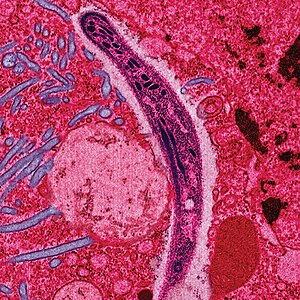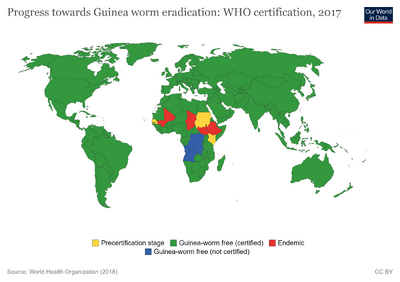Parasitic disease
| Parasitic disease | |
|---|---|
| Other names: parasitosis, parasitic infection | |
 | |
| False-color electron micrograph of a Plasmodium sporozoite | |
| Specialty | Infectious disease |
A parasitic disease, also known as parasitosis, is an infectious disease caused by parasites.[citation needed]
Parasites are organisms which derive sustenance from its host while causing it harm.[1]
The study of parasites and parasitic diseases is known as parasitology.[2]
Medical parasitology is concerned with three major groups of parasites: parasitic protozoa, helminths, and parasitic arthropods.[1]
Parasitic diseases are thus considered those diseases that are caused by pathogens belonging taxonomically to either the animal kingdom, or the protozoan kingdom.[3]
Transmission

Mammals can get parasites from contaminated food or water, bug bites, sexual contact,[4] or contact with animals.
Some ways in which people may acquire parasitic infections are walking barefoot, inadequate disposal of feces, lack of hygiene, close contact with someone carrying specific parasites, and eating undercooked foods, unwashed fruits and vegetables or foods from contaminated regions.[citation needed]
Treatment
Parasitic infections can usually be treated with antiparasitic drugs.[citation needed] The use of viruses to treat infections caused by protozoa has been proposed.[5][6]
Terminology
Although organisms such as bacteria function as parasites, the usage of the term "parasitic disease" is usually more restricted. The three main types of organisms causing these conditions are protozoa (causing protozoan infection), helminths (helminthiasis), and ectoparasites.[7] Protozoa and helminths are usually endoparasites (usually living inside the body of the host), while ectoparasites usually live on the surface of the host. Protozoa are single-celled, microscopic organisms that belong to the kingdom Protista. Helminths on the other hand are macroscopic, multicellular organisms that belong to the kingdom Animalia. Protozoans obtain their required nutrients through pinocytosis and phagocytosis. Helminths of class Cestoidea and Trematoda absorb nutrients, whereas nematodes obtain needed nourishment through ingestion.[3] Occasionally the definition of "parasitic disease" is restricted to diseases due to endoparasites.[8]
References
- ↑ 1.0 1.1 Baron, Samuel, ed. (1996), "Introduction to Parasitology", Medical Microbiology (4th ed.), Galveston (TX): University of Texas Medical Branch at Galveston, ISBN 978-0-9631172-1-2, PMID 21413318, archived from the original on 2022-05-20, retrieved 2022-06-21
- ↑ "Parasitology - Latest research and news | Nature". www.nature.com. Archived from the original on 2022-06-21. Retrieved 2022-06-21.
- ↑ 3.0 3.1 Sherris medical microbiology. Ryan, Kenneth J. (Kenneth James), 1940- (Seventh ed.). New York. 2018-01-12. ISBN 9781259859816. OCLC 1004770160.
{{cite book}}: CS1 maint: others (link) - ↑ "Parasitic Diseases". Archived from the original on 2010-07-06. Retrieved 2010-07-07.
- ↑ Keen, E. C. (2013). "Beyond phage therapy: Virotherapy of protozoal diseases". Future Microbiology. 8 (7): 821–823. doi:10.2217/FMB.13.48. PMID 23841627.
- ↑ Hyman, P.; Atterbury, R.; Barrow, P. (2013). "Fleas and smaller fleas: Virotherapy for parasite infections". Trends in Microbiology. 21 (5): 215–220. doi:10.1016/j.tim.2013.02.006. PMID 23540830.
- ↑ "About Parasites | CDC DPD". 2020-01-28. Archived from the original on 2010-10-14. Retrieved 2022-08-13.
- ↑ "Intestinal Protozoal Diseases: eMedicine Pediatrics: General Medicine". Archived from the original on 2010-03-16. Retrieved 2010-04-25.
External links
| Classification |
|---|
- Pages with script errors
- CS1 maint: others
- All articles with unsourced statements
- Articles with unsourced statements from June 2022
- Articles with invalid date parameter in template
- Articles with hatnote templates targeting a nonexistent page
- Articles with unsourced statements from June 2021
- Portal templates with all redlinked portals
- Parasitic diseases
